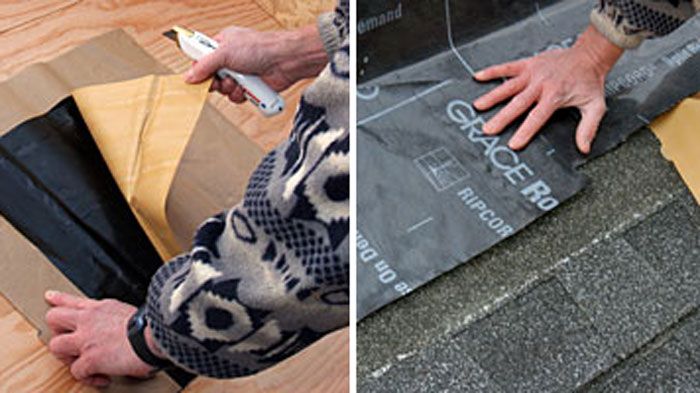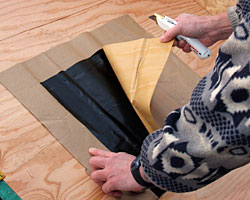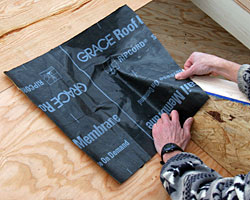
Peel-and-stick membranes allow a level of protection and redundancy when flashing a dormer that wasn’t available before the introduction of modern waterproofing materials. The process involves some forethought, mainly because a portion of it has to be done before you’re finished framing.
For example, the first pieces of membrane have to be installed after the wing walls are in place, but before the roof is framed. That’s because the rafters’ overhang makes it almost impossible to get the membrane in place at the critical juncture where the top of the cheek meets the main roof. I like to use Grace’s Roof Detail Membrane because it comes in a convenient 18-inch width and there are ripcords embedded beneath the release sheet which can be used to separate it into more manageable sections making it easy to peel only the paper you want to remove at a given time.
Steps for installing watertight dormers
| After cutting an 18-in. square of peel and stick membrane, use a new blade and carefully score the release paper backing to leave an L-shaped, 2-in.-wide, strip of paper on two edges of the membrane. |  |
| Press the membrane into place at the top of the wing wall so that it overlaps the top plate and the roof sheathing. The strips of release paper should be on the bottom edge and the edge on the roof sheathing. Leaving the paper on the membrane for now makes it possible to slide the other membrane and other roofing materials (felt underlayment, roof shingles) underneath the edges of this first piece later on. |  |
| After completing the rest of the dormer framing, cut a piece of flashing about a foot and a half longer than the front wall of the dormer, so that it can overhang each corner of the front wall by about 8-10 inches. |  |
| Remove the release sheet from the top half of the length of membrane and press it onto the front wall of the dormer making sure to work it tightly into the inside corner to prevent any voids. Remove about half of the remaining release sheet lengthwise from the lower section and press the exposed membrane on to the sheathing leaving the paper on the bottom half. Slice the membrane at approximately 45 degrees so you can fold it onto the wing wall. Leave the release sheet on the bottom half of membrane so roof shingles can slide under it later. |  |
| From an approximately 10-inch long scrap of membrane, cut a piece shaped like a bow-tie. |  |
| Remove the release paper and stretch the membrane around the corner where the wing wall meets the dormer’s front wall. This helps seal the weak spot created by cutting the membrane at the outside corner. |  |
| Cut a length of membrane approximately 10 inches longer than the length of the wing-wall cheek, and use multiple pieces if the wall is longer than 5 or 6 feet. Make sure to apply multiple sheets from the bottom up to avoid reverse lapping. Fold lengthwise and remove paper from one half of the length. Slide the membrane up the roof along the wing wall placing it so that the half with the release paper is on the roof. |  |
| Reach under the roof overhang and lift up the edge of the first piece of membrane and slide the cheek piece under the first piece of membrane. Remove the paper from the first piece and press onto cheek membrane piece. |  |
| Remove the paper from the first piece and press onto the cheek membrane piece. |  |
| Then remove the inner half of the paper from that part of the membrane that’s on the roof and press in place, again working the inside corner to prevent voids. Leave the last paper strip in place for now. |  |
| At the bottom end of the wing wall membrane piece, slice the membrane at approximately 45 degrees at the bottom of the cheek so you can fold it onto the front wall (similar to what you did with the front wall membrane piece). |  |
| When its time to install the roofing, there are a couple things to remember to assure a water tight dormer. When you cover the roof with felt or a similar underlayment — I prefer using synthetic underlayment — lift the front-wall and cheek membrane pieces and slide the underlayment under the membrane. Once the underlayment is beneath the membrane along the cheek, remove the remaining release sheet and press the membrane to the felt |  |
.
But don’t remove the paper from the front-wall paper strip until the upper half of the asphalt shingles is slid underneath the membrane. This provides a direct path to the outside of the roof covering for any water that finds its way through. Once the roof is complete, I flash the dormer with metal flashing as usual. The membrane is only a backup and should not replace the primary flashing system.
To learn how Rick Arnold builds and installs this traditional style of dormer, read his article Doghouse Dormers.
— Photos by Roe A. Osborn
Fine Homebuilding Recommended Products
Fine Homebuilding receives a commission for items purchased through links on this site, including Amazon Associates and other affiliate advertising programs.

Stabila Extendable Plate to Plate Level

Guardian Fall Protection Pee Vee

Hook Blade Roofing Knife






View Comments
Great effort